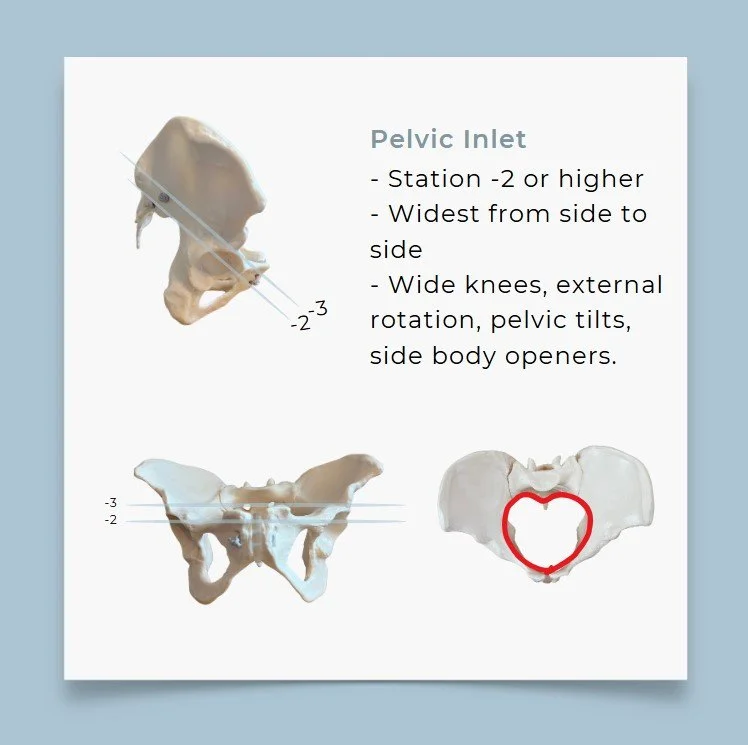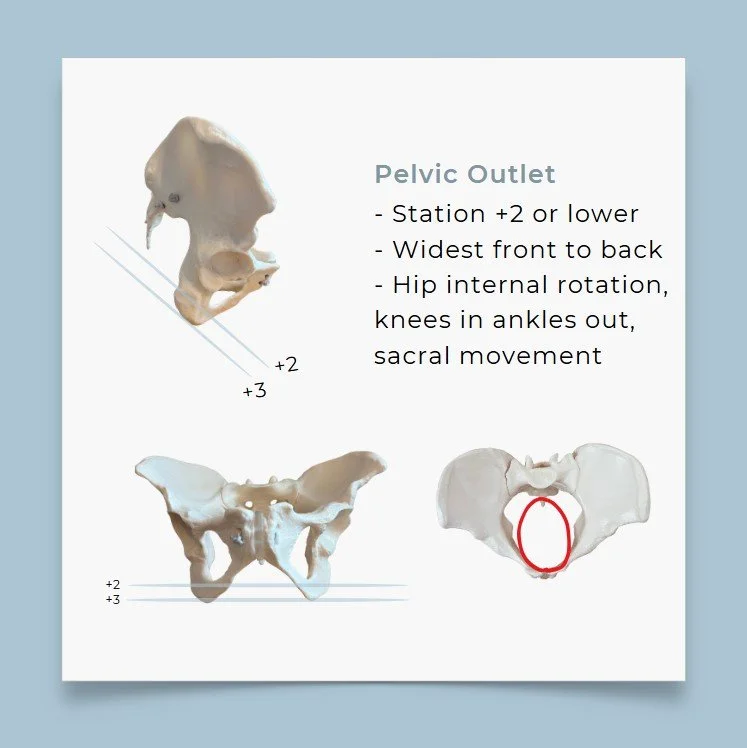What is the best labor position?
The answer is, it depends!
It depends on how far into your pelvis the baby is. And that’s because your pelvis has three levels (inlet, midpelvis, and outlet). There are different types of movements that are beneficial for each pelvis level.
Let’s start by reviewing what the “stations” of labor are, and then correlate it to the level of the pelvis. Then we’ll cover the types of movements that are beneficial for each level of the pelvis (with examples!).
Labor Stations
When you’re in labor, medical staff might tell you what “station” your baby is at. They physically feel where the baby’s head is in relation to bony structures of the pelvis. Here’s a break down of labor stations:
Summary of Stations of Labor
Station -3 to -1 - this is the pelvic inlet, where baby is starting to lower into & engage in the pelvis .
Station -1 to +1 - this is the midpelvis, where the baby starts to make it’s turn.
Station +1 to +3 - this is the pelvic outlet, where baby makes it under the pubic bone and pushing happens.
Note that Station 0 equates to the level of the pelvis where the ischial spines are.
Not everyone wants internal exams and that’s okay. While knowing baby’s station might help you (or your support person) know what types of movements would be beneficial, YOU know your body best. Knowing baby’s station is not necessary.
Your body will give you clues on what types of movements feel the best. You might feel the drive to rock, or sway, or be on all-fours. Don’t be afraid to list to your own intuition.
Now let’s break down each pelvis level.
Pelvic Inlet
Before you go into labor and at the start of labor, baby will be positioned at or above the pelvic inlet (or top of the pelvis). The pelvic inlet is widest from side to side. To help the baby engage & open the pelvic inlet, you want to focus on two things:
Total body balance and hip external rotation. Both are described below.
You want to find balance within your entire abdomen & uterine ligaments. Muscle or ligament tightness on one side of the body can put pressure on baby and impact baby’s overall position. This is part of why it’s so important to work on thoracic rotation, spinal mobility, inversions, and side body openers during pregnancy. These movements will help keep your abdominal muscles and uterine ligaments balanced to support optimal baby position.
You also want to focus on hip external rotation and pelvic tilts, which will widen the top of the pelvis and help make room for baby to engage. Here are some example exercises that are helpful:
Deep Squat routine - spending time in the deep squat is a great way to open the pelvic inlet. Think knees pressed out wide. You can also do these supported with a birth sling or holding on to rings/TRX.
Rocking knees out ankles in - this is a great alternative if the deep squat isn’t comfortable.
Wall pelvic tilts - practice moving your pelvis forward and backward. Stand supported at the wall, do it on a birth ball, try it on all-fours.
These types movements are great to start doing at any time during pregnancy, or in early labor.
Midpelvis
The midpelvis (or middle of the pelvis) is widest on the diagonal. This is where baby starts making it’s turn, ideally so that the back of baby’s head is towards the pubic bone in the front.
To help the baby move through the midpelvis, use side to side, diagonal, lateral, and swaying movements.
Some example exercises that are good to open the midpelvis are listed below:
Half Kneeling Lateral Lunge - do this on the ground (as in the video) or lean onto a ball
Hip Shift Pelvic Tilts - The hip shift helps open the back side of the pelvis and the pelvic tilts encourage additional movement in this position.
Wall Supported hip shift - open the back of the pelvis as you’re moving side to side.
Pelvic Outlet
The pelvic outlet (or bottom of the pelvis) is widest front to back. When the baby is in the pelvic outlet, you’re at the pushing stage.
When you push, you want to use internal rotation to open the pelvic outlet as much as possible (think knees in, ankles out). You also want to leave the sacrum free to move out of the way.
Pregnancy is very external rotation biased (hips wide, feet pointed out), so I find it’s really important to work on internal rotation during pregnancy so you have access to it during labor.
Here are some exercises to improve or maintain internal rotation during pregnancy.
Here are some exercises more specific to birth and pushing prep.
Some great pushing positions to use to be able to access both hip internal rotation and sacral movement are side lying (hold the top leg in internal rotation with knee in and ankle out), all-fours (with knees in and ankles out), or even lying on your back with a towel roll or pillow under the top of your pelvis to free up space for the sacrum and tailbone to move (still have knees in, ankles out).
Birth Prep Starts Early in Pregnancy
Many people feel compelled to start birth prep once they hit weeks 36+ and feel like labor is coming. But if I could convince you of one thing, it would be to start birth prep sooner. Pelvic mobility is a key component of labor (especially if you have been told you have a small pelvis or your baby is too big!!). Start working on pelvic mobility during pregnancy so you have the strength and range of motion during labor.
It also has the added benefit of increasing your overall comfort during pregnancy!
Pelvic mobility & stability is a huge part of my Weeks 4-42 pregnancy fitness program. It syncs to your week during pregnancy & includes a birth prep routine closer to labor.
The prenatal program is part of my Functional Empowered Fitness (FEF) Membership. After you have the baby, you’ll move seamlessly into the Postpartum Reconnect program for weeks 0-6 (gentle breathing & mobility), and then the Postpartum Rebuild program to rebuild your foundation of strength, breathing, and mobility.
I’d love to have you join. Find out more information at the link below below!
More Resources
I hope you found this post helpful & feel more prepared for birth. If you want some more general recommendations for fitness during pregnancy, be sure to check out this blog post which breaks it all down & gives a guide you can keep.





